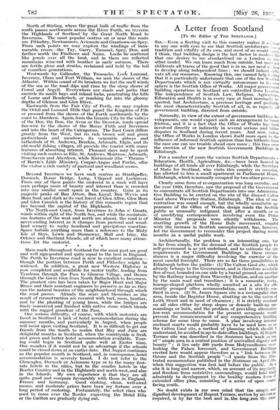A Letter from Scotland
[To the Editor of THE SPECTATOR.] SIR,—Even a fleeting visit to this country makes it evident to any one with eyes to see that Scottish architecture has a tradition and vitality of its own, and most of us would :.2yee, I think, that building design is the last factor in modem life that one desires to see standardized -on a London or any other model. We can learn much from outside, but need nut obliterate all traces of the -good that is in us, nor need w fear to develop' along independent lines ; we should indeed culti- vate all our resources. Knowing this, one' cannot help f, cling that it is particularly unfortunate that one of the few Scottish Departments which is not virtually autonomous in its own sphere is the Scottish Office of Works. All major government building operations in Scotland are controlled from London. The independence of Scottish Law, Religion, Agriculture, Education and Health is in every case at least nominally re- spected, but Architecture, a precious heritage and probably the most characteristically Scottish of all, is, as regards all government building, directed from outside.
Naturally, in view of-the extent of government building de- velopments, one would expect such an arrangement to breed friction, and it is a fact that the Office of Works has been involved directly or indirectly in several serious and bitter disputes in Scotland during recent years. And now, unless the Office of Works in London shows itself more open to the influence of informed Scottish opinion than has hitherto been the case one can see trouble ahead once more ; this time over the erection of the new Scottish Government Buildings in Edinburgh.
For a number of years the various Scottish Departments— Education, Health, Agriculture, &c.—have been housed in buildings of all kinds all over Edinburgh, while the Secretary of State for Scotland, who visits this country on occasion, has allotted to him a small apartment in Parliament House, Edinburgh, which is normally occupied by two other persons.
Clearly some form of re-organization was long overdue, and the year 1930, therefore, saw the proposal of the Government to concentrate all Scottish Departments into one Administra- tive Building to be erected on the site of the disused Calton Gaol above Waverley Station, Edinburgh. The idea of con- centration was sound enough, but the wholly unsuitable ap- pearance of the Office of Works design made the Scottish public so unusually indignant that after a month or so of unedifying correspondence involving even the Prime Minister the proposals were silently withdrawn. The startling growth of the Home Rule movement, coupled with the increase- in Scottish unemployment, has, however, led the Government to reconsider this project during recent months as a useful public work.
Architecturally, the problem is an interesting one, but is far from simple, for the demand of the Scottish people for self-government is as yet undefined, and to estimate the site requirements for Government Buildings in these circum- stances is a major difficulty involving the exercise of the most careful foresight. There are so far three possibilities in Edinburgh before the public : (1) The Calton Gaol site, which already belongs to the Government, and is therefore available free of cost, bounded on one side by a burial ground, on another by the Railway issuing from Waverley Station, and on another by the main road and tramlines ; it is a romantic, rocky, lozenge-shaped platform wholly .unsuited as a site for effi- ciently grouped office accommodation, and is strictly con- fined in area. (2) St. James Square site is a rectangular slum area, beside the Register House, abutting on to the canon of Leith Street and in need of clearance ; it is strictly confined on all sides either by steep slopes or densely built-up sur- roundings or both, and the problem of providing alternative low-rent accommodation for the present occupants would prevent the commencement of any comprehensive building scheme for some time to come. A. plan involving internal enclosed courts would probably have to be used here as on the Calton Gaol site, a method of planning which' should, I
understand, be avoided in up-to-date office buildings. 3) Regent Terrace site was described in the Scotsman last week as one
of " ample area in a central position of unrivalled dignity and
beauty ; it lies only 300 yards from Holyroodhouse over- looking the Palace forecourt, and Government Buildup
erected here would appear therefore as a " link between the
throne and the Scottish people "—I quote from the illus- trated memorandum published in the Scotsman on April 5th,
when this suggestion was first laid before the public. As a site it is long and narrow, which, on account of its regularity and freedom from restrictive surroundings, would lend itself admirably to development by the healthy modern form of extended office plan, consisting of a series of open courts facing south.
No doubt exists in my own mind that the simple and dignified development of Regent Terrace; section by section at required, is by far the best and in the long ...run the most
economical solution of the problem that has yet been sug- gested ; and as the neighbourhood of this site has the unique advantage of being both central and uncongested it would be possible by 'means of Town-planning safeguards to provide for future political or other developments without involving the Government of to-day in extra expense.—I am, Sir, &c.,
YOUR CORRESPONDENT IN SCOTLAND.

















































 Previous page
Previous page